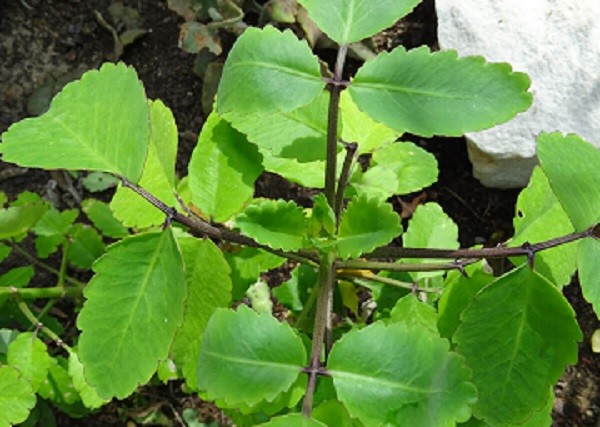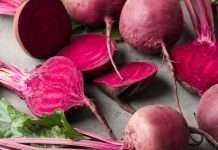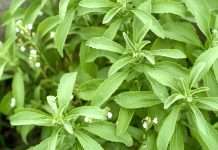
Bryophyllum pinnatum (Fam. Crassulaceae) is a succulent perennial herb, which grows up to 1m to 2m in height. It is known by several names such as “wonder of the world”, “miracle leaf”, “resurrection plant”, “cathedral bells”, “Goethe plant”, “sacred plant”, “good luck leaves”, “never die plant”, “air plant”, or “life plant.” It is known as karan masarachi in Hausa, odaa opue in Ibo, ewe abamoda or odundun in Yoruba, and da bu si in Chinese. To the Edo, it is danweshin or ekpokpo. It is afiayo in Efik and umbu in Ijo-Izon.
Constituents
The leaves of B. pinnatum have been reported to have flavonoid, phenolic compounds, alkaloids, terpenoids, carbohydrates, minerals and glycosides. Compounds identified include oleic acid, alpha-D-Glucopyranoside, methyl, n-Hexadecanoic acid, Octadecanoic acid, 3,5-Dihydroxy-6- methyl-2,3-dihydro-4H-pyran-4-one and Benzaldehyde. They also contain vitamins like ascorbic acid, thiamine, riboflavin and niacin; also minerals like calcium, zinc and phosphorus, potassium, sodium.
Preparations
Pinnatum may be used as raw leaves. The leaves may be lightly roasted, heated, made into infusion, juice mixed with coconut oil. The roots and stem may also be used as infusions.
Pharmacological actions and medicinal uses
The leaves of B. pinnatum are known for their antinociceptive, anti-inflammatory and antidiabetic activity, antihypertensive activity, immunosuppressive effect, antibacterial, antiviral, antifungal, antihistamine, anaphylactic and anti-tumour activities. Antiulcer potentials of herbal drug have been reported in various scientific studies. Bryophyllum pinnatum is used for the treatment of cough, asthma, cold (with candy sugar), dysentery, fever, constipation, boil, wound, sore or cuts, leucorrhoea and roundworm infestation. It is a natural remedy for teething trouble (when mixed with honey) and ear pain.
Researchers have established the gastroprotective effect of aqueous extract and mucilage from Bryophyllum pinnatum against peptic ulcers.
In a study, both the aqueous and methanolic leaf extracts of B. pinnatum produced dose-related, significant decreases in arterial blood pressures and heart rates of anaesthetised normotensive and hypertensive rats. Another study concluded that Bryophyllum pinnatum may be a suitable treatment for sleep problems of cancer patients. It has importance in the treatment of certain types of cancer.
The rhizome of this plant can be used for the prevention and treatment of kidney and gall bladder stones. It has diuretic properties, alleviates difficult urination, helps to cleanse the bladder and intestines of harmful toxins. The intestinal cleansing properties can definitely contribute to weight loss; thus its usefulness in weight management. The root of this plant is believed to be hepato-protective and proved useful for the treatment of jaundice and hepatitis. It is used as a home remedy for piles. The extract is used for the nourishment of the hair and treating grey hair.
Adverse effects
There are very scanty reports of discomforts such as fatigue, dry throat, agitation and difficult digestion from the use of B. pinnatum. It may interact or reduce the efficacy of Aspirin. The plant should not be used in pregnancy.
Economic uses and potentials
- pinnatum is often used as an ornamental plant; it makes a very decorative addition to the garden. The pharmacological properties render it a possible candidate for the development of novel drug substances as well as for cosmetics. There are potentials in the large scale cultivation, research and development of resurrection plant for medicinal use.
By Pharm. Ngozika Okoye
Pharm., MSc (Clinical Pharmacy), MPH, FPCPharm (Nigeria Natural Medicine Development Agency)













